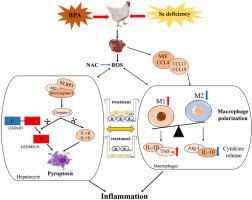Environmental Pollution ( IF 7.6 ) Pub Date : 2023-03-09 , DOI: 10.1016/j.envpol.2023.121392 Xu Shi 1 , Tong Xu 1 , Xiaojing Li 2 , Xinyue Sun 1 , Wenyue Zhang 1 , Xiaojing Liu 1 , Yuqi Wang 1 , Yilei Zhang 1 , Shiwen Xu 3

|
The earth's natural environmental factors and man-made industrial pollution often lead to the co-occurrence of environmental pathogenic factors and malnutrition. Bisphenol A (BPA) is a serious environmental endocrine disruptor, and its exposure can cause liver tissue damage. Selenium (Se) deficiency is a worldwide problem that afflicts thousands of people, and Se deficiency can cause M1/M2 imbalance. In addition, the crosstalk between hepatocyte and immune cell is closely related to the occurrence of hepatitis. Therefore, this study found for the first time that the combined exposure of BPA and Se deficiency caused liver pyroptosis and M1 polarization through ROS, and the crosstalk between pyroptosis and M1 polarization aggravated liver inflammation in chicken. In this study, the BPA or/and Se deficiency chicken liver, single and co-culture model of LMH and HD11 cells were established. The results displayed that BPA or Se deficiency induced liver inflammation accompanied by pyroptosis and M1 polarization through oxidative stress, and increased expressions of chemokines (CCL4, CCL17, CCL19, and MIF) and inflammatory factors (IL-1β and TNF-α). The vitro experiments further verified the above changes and showed that LMH pyroptosis promoted M1 polarization of HD11 cells, and vice versa. NAC counteracted pyroptosis and M1 polarization caused by BPA and low-Se, reducing the release of inflammatory factors. In brief, BPA and Se deficiency treatment can exacerbate liver inflammation by increasing oxidative stress to induce pyroptosis and M1 polarization.
中文翻译:

ROS介导的细胞焦亡-M1极化串扰参与双酚a和缺硒诱导的鸡肝炎症
地球的自然环境因素和人为的工业污染往往导致环境致病因素和营养不良并存。双酚 A (BPA) 是一种严重的环境内分泌干扰物,其暴露会导致肝组织损伤。硒 (Se) 缺乏症是一个世界性的问题,困扰着成千上万的人,硒缺乏会导致 M1/M2 失衡。此外,肝细胞与免疫细胞的串扰与肝炎的发生密切相关。因此,本研究首次发现BPA和Se缺乏联合暴露通过ROS引起肝细胞焦亡和M1极化,焦亡和M1极化之间的串扰加重了鸡的肝脏炎症。在这项研究中,BPA 或/和缺硒鸡肝,建立了LMH和HD11细胞的单培养和共培养模型。结果表明,BPA 或 Se 缺乏通过氧化应激诱导肝脏炎症并伴有细胞焦亡和 M1 极化,并增加趋化因子(CCL4、CCL17、CCL19 和 MIF)和炎症因子(IL-1β 和 TNF-α)的表达。体外实验进一步验证了上述变化,表明LMH细胞焦亡促进了HD11细胞的M1极化,反之亦然。NAC 抵消了由 BPA 和低硒引起的细胞焦亡和 M1 极化,减少了炎症因子的释放。简而言之,BPA 和 Se 缺乏治疗可通过增加氧化应激诱导细胞焦亡和 M1 极化来加剧肝脏炎症。结果表明,BPA 或 Se 缺乏通过氧化应激诱导肝脏炎症并伴有细胞焦亡和 M1 极化,并增加趋化因子(CCL4、CCL17、CCL19 和 MIF)和炎症因子(IL-1β 和 TNF-α)的表达。体外实验进一步验证了上述变化,表明LMH细胞焦亡促进了HD11细胞的M1极化,反之亦然。NAC 抵消了由 BPA 和低硒引起的细胞焦亡和 M1 极化,减少了炎症因子的释放。简而言之,BPA 和 Se 缺乏治疗可通过增加氧化应激诱导细胞焦亡和 M1 极化来加剧肝脏炎症。结果表明,BPA 或 Se 缺乏通过氧化应激诱导肝脏炎症并伴有细胞焦亡和 M1 极化,并增加趋化因子(CCL4、CCL17、CCL19 和 MIF)和炎症因子(IL-1β 和 TNF-α)的表达。体外实验进一步验证了上述变化,表明LMH细胞焦亡促进了HD11细胞的M1极化,反之亦然。NAC 抵消了由 BPA 和低硒引起的细胞焦亡和 M1 极化,减少了炎症因子的释放。简而言之,BPA 和 Se 缺乏治疗可通过增加氧化应激诱导细胞焦亡和 M1 极化来加剧肝脏炎症。体外实验进一步验证了上述变化,表明LMH细胞焦亡促进了HD11细胞的M1极化,反之亦然。NAC 抵消了由 BPA 和低硒引起的细胞焦亡和 M1 极化,减少了炎症因子的释放。简而言之,BPA 和 Se 缺乏治疗可通过增加氧化应激诱导细胞焦亡和 M1 极化来加剧肝脏炎症。体外实验进一步验证了上述变化,表明LMH细胞焦亡促进了HD11细胞的M1极化,反之亦然。NAC 抵消了由 BPA 和低硒引起的细胞焦亡和 M1 极化,减少了炎症因子的释放。简而言之,BPA 和 Se 缺乏治疗可通过增加氧化应激诱导细胞焦亡和 M1 极化来加剧肝脏炎症。















































 京公网安备 11010802027423号
京公网安备 11010802027423号